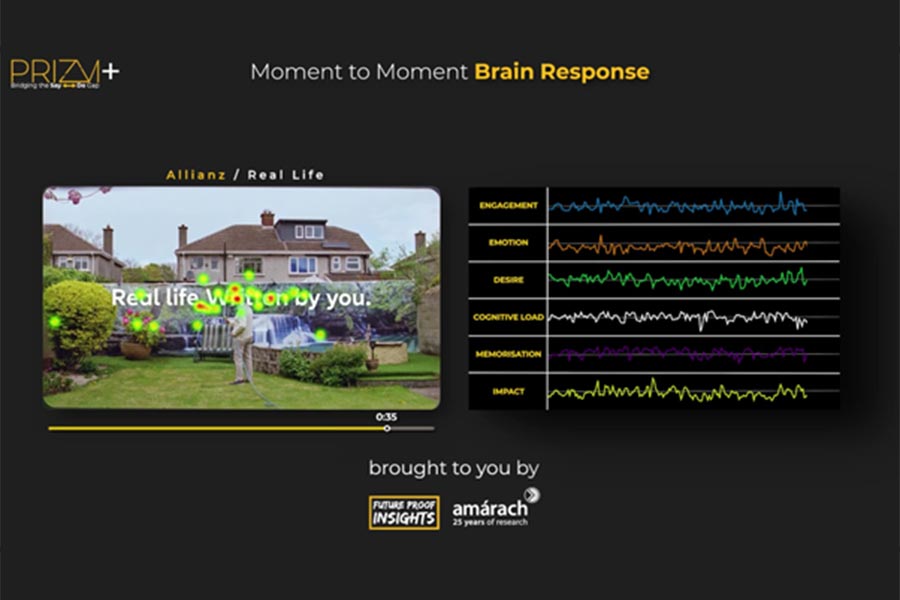Every week, Amárach and Future Proof Insights share exclusive findings from their PRIZM+ ad testing service, showcasing best practice creative advertising in Ireland.
Allianz’s “Real Life” campaign reflects a simple truth: life is unpredictable and full of real challenges.
Through a rapid sequence of authentic vignettes, it captures everyday moments most people will recognise: parents with their kids, people in their kitchens, grandparents in gardens, and friends at the local pitch.
While these scenes feel relatable, they enter a crowded space: many brands, from retailers and banks to telcos and CPGs, work hard to associate themselves with the fabric of daily life.
It’s a logical approach, but one that’s difficult to defend and differentiate outside of your own category.
The ad takes a risk by holding all category and brand cues until the final reveal.
In a quick-cut montage, where frequent scene changes raise cognitive load and force the audience to work harder to make sense of the sequence, this risks diluting brand association.
Without mid-spot cues to tether the narrative, viewers may recall the ad but misattribute it to another brand or even another category.
From a neuroscience perspective, “Real Life” delivers frequent peaks in attention and emotion, which is typical of montage execution.
These bursts of novelty grab attention, but they also mean viewers often don’t feel an emotional connection until the point where the story’s purpose becomes clear.
Once that context clicks into place, the brain locks the message in more firmly, a process known as conceptual closure, where people feel a sense of satisfaction from finally understanding how it all fits together.
The emotional peaks tend to occur when viewers can engage in empathic simulation, mentally placing themselves in the situations on screen.
Yet with such consistent mental demand, many process the creative intellectually before feeling it emotionally.
Desire to act emerges in bursts, often linked to personal relevance, but drops when the montage shifts too quickly.
Montage Execution Framework
A well‑executed montage rests on a few core principles that help keep viewers hooked and ensure the brand stays woven into the story. At its best, a montage:
- Anchor the Theme Early: Clearly establish the point of the ad so viewers know what they’re watching and why it matters. In “Real Life,” the Allianz logo appears at the start, but thematic hints to connect it to insurance are missing until the very end.
- Balance Busy and Simple Shots: Mix high-detail sequences with simpler, calmer moments to help the audience process the story without fatigue. The ad strikes this balance in places, though some dense sequences push mental effort to the limit.
- Space Emotional Peaks: Spread key emotional moments throughout to keep interest high from start to finish. Here, the biggest emotional lifts come late, leaving the first half carrying the cognitive load without equivalent payoff.
- Hold Faces for Empathy: Let viewers linger on expressions long enough to feel connected. Faces are present, but they pass too quickly for deeper connection.
- Repeat Brand Cues Subtly: Integrate brand elements throughout, not just in the opening or final frames. Brand signals bookend the ad, but are absent in the middle, reducing linkage.
- Add Mini-Moments of Closure: Give viewers smaller ‘aha’ points along the way to reward their attention before the final reveal. The ending lands well, but the journey could benefit from more satisfying beats en route.
Looking at “Real Life” through this lens shows a mixed picture.
The logo appears at the start, but thematic hints that would help viewers join the dots earlier are missing.
At times, the edit finds a good balance between busy and simple shots, but in other places, clusters of detail‑heavy scenes push mental effort to its limit.
The biggest emotional lifts come late, leaving the early sections to carry more of the mental work without the same pay‑off.
Faces are there, but they flash past too quickly for viewers to truly connect.
Brand signals book‑end the ad with little in‑between reinforcement.
And while the ending lands well, earlier ‘aha’ moments could have made the journey feel more rewarding throughout.
COM-B Analysis and Demographic Insights
From a behavioural perspective, the ad performs strongest on Motivation, driven by reflective motivation.
Viewers see the values and everyday situations they relate to reflected back at them.
Capability is also clear; the narrative is easy to follow, and Allianz’s supportive positioning is understood once the reveal lands.
Opportunity, however, is the softer dimension. Without a prompt or contextual cue in the middle of the creative, there’s little to translate emotional alignment into immediate action.
Segmenting the results shows the campaign resonated most with adults aged 25–44, particularly parents and those in multi‑generational households, who recognise and relate to the mix of family and community scenes.
Engagement is less consistent among older non‑parents, where the lack of explicit category cues may have contributed to a weaker linkage between the ad and Allianz.
Regional differences were minimal, though urban audiences were slightly more responsive to the pace and variety of the montage.
This segmentation reinforces a clear learning: if the brand wants to extend reach beyond its core, it will need to adjust the creative to introduce thematic or brand signals earlier and ensure the everyday life positioning is tied explicitly to the insurance category throughout the journey.

The Takeaway for Marketers
“Real Life” is a strong example of both the power and the pitfalls of montage storytelling.
The variety, pace, and relatability of its scenes pull viewers in, but the lack of early thematic framing and brand reinforcement leaves too much heavy lifting to the final moments.
That means even good recall and sticky imagery risk being undercut by misattribution or weak category linkage.
For marketers, the lesson is clear: balance the human, everyday tone with signposts that make the brand and category impossible to miss.
Anchor the theme early, mix dense and simple moments to keep cognitive load in check, spread emotional peaks across the runtime, give viewers time with faces to trigger empathy, and weave in subtle brand cues from start to finish so the story and the brand remain inseparable in the audience’s mind.
For more insights from PRIZM+ on how neuroscience drives advertising impact, visit: https://www.futureproofinsights.ie/prizm-plus/









